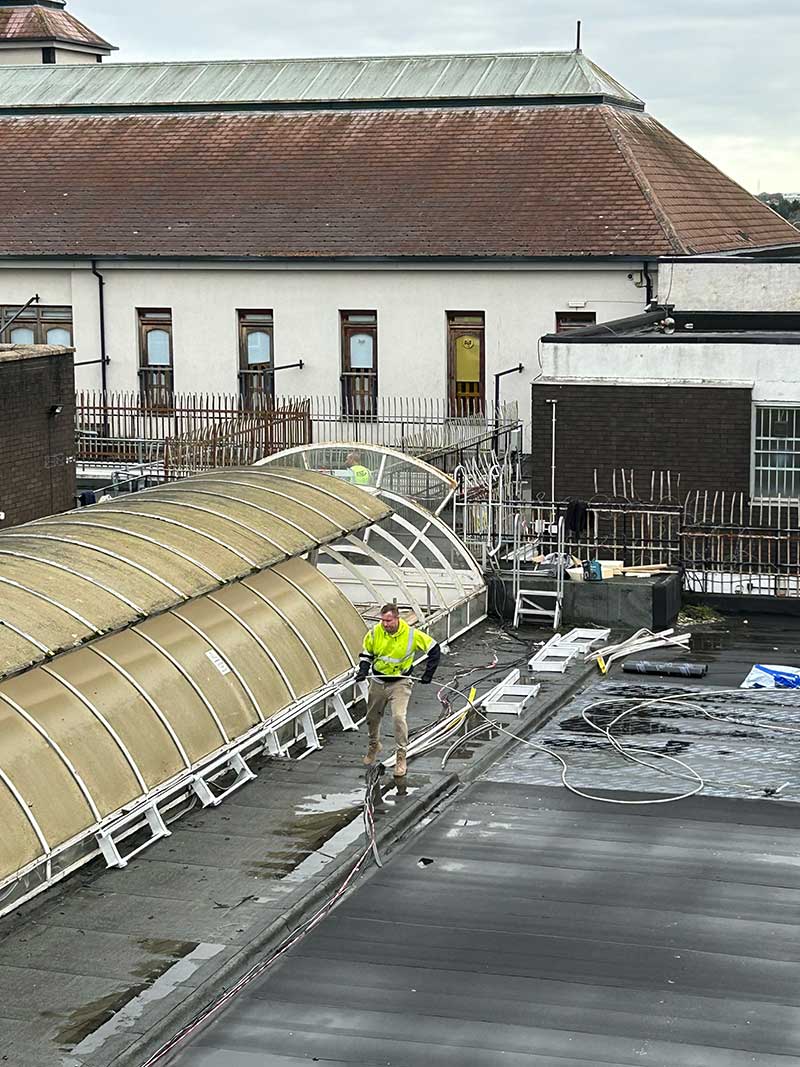
The roof of a manufacturing facility is more than a structural necessity—it’s an integral part of the building’s overall performance, safety, and efficiency. Yet, due to the intense and varied nature of industrial operations, these roofs face challenges far beyond the ordinary.
Unlike standard commercial units, manufacturing sites must contend with heavy mechanical equipment, high internal heat, airborne chemicals, and frequent access for maintenance—all of which place unique demands on the roof system.
Below, we examine four common roofing challenges in manufacturing environments: ventilation, loading stress, chemical exposure, and roof access logistics. Understanding these issues is key to ensuring the longevity and reliability of your facility’s roofing system.
1. Ventilation and Heat Build-Up
Manufacturing facilities often generate significant internal heat due to machinery, lighting, and production processes. Without proper ventilation, this heat can rise and become trapped beneath the roof deck, leading to several problems:
Why It Matters
-
Thermal Stress: Repeated heat cycles cause expansion and contraction of roofing materials, which may lead to cracks, delamination, or joint failure.
-
Condensation Risk: Warm, moist air from production areas can condense on cooler underside surfaces of the roof. Over time, this can cause dampness, rust, or even mould within the roof structure.
-
Worker Comfort and Equipment Performance: Poor ventilation can increase internal temperatures, impacting both staff wellbeing and the efficiency of temperature-sensitive machinery.
Mitigation Strategies
-
Incorporating roof vents, smoke vents, or continuous ridge ventilation
-
Installing breathable vapour control layers
-
Considering cool roof materials or reflective membranes to manage solar gain
Efficient airflow through and out of the roof cavity helps stabilise internal conditions and prevents moisture-related issues from taking root.
2. Loading Stress from Equipment and Plant Installations
Manufacturing roofs are often used to house essential building systems—air handling units, chillers, extraction fans, solar panels, and occasionally even access platforms or walkways. These installations impose point loads and static stress on the roof structure.
Why It Matters
-
Structural Deflection: Older or inadequately designed roofs may sag under the weight of heavy mechanical plant, risking pooling water and structural fatigue.
-
Membrane Damage: Foot traffic and mechanical vibrations can wear or puncture roofing membranes, especially if the roof lacks proper walkways or protection pads.
-
Dynamic Loads: Equipment that operates with moving parts (e.g., fans or compressors) may introduce cyclical stress and vibration into the structure.
Mitigation Strategies
-
Load assessments and reinforcement in mounting areas
-
Isolating vibrations with specialist fixings
-
Installing designated plant zones with protection layers and access platforms
Manufacturing roofs must be designed or retrofitted with load-bearing capacity in mind, especially when equipment is upgraded or repositioned.
3. Chemical Exposure and Airborne Contaminants
Many manufacturing operations release vapours, particles, or residues that can eventually affect the roof. These may include oils, solvents, exhaust fumes, or acidic compounds depending on the industry.
Why It Matters
-
Membrane Degradation: Certain roofing materials (e.g. bitumen or low-grade plastics) may react negatively to chemical exposure, breaking down prematurely.
-
Corrosion: Metallic components, fixings, or drainage systems may corrode when exposed to acidic or oily residues, particularly near exhaust ducts or extraction vents.
-
Contaminant Build-Up: Accumulated dust, grease, or chemicals can clog gutters, block outlets, and increase the risk of ponding or leaks.
Mitigation Strategies
-
Selecting chemical-resistant membranes like EPDM, TPO, or PVC
-
Installing protective hoods or duct extensions to redirect exhaust away from the roof
-
Regular roof cleaning and inspection, especially near exhaust zones
Material compatibility with site-specific pollutants should always be verified at the design stage or during refurbishment.
4. Roof Access Logistics and Safety Concerns
Manufacturing roofs are rarely passive. Technicians frequently access them for HVAC servicing, equipment checks, gutter clearance, or compliance inspections. Ensuring safe, reliable access—without damaging the roof—is a constant balancing act.
Why It Matters
-
Foot Traffic Damage: Repeated visits, especially in wet or icy conditions, can scuff, tear, or compress roof materials, particularly if access paths aren’t clearly defined.
-
Trip Hazards: Cables, pipework, low parapets, and loose equipment can pose safety risks for anyone accessing the roof.
-
Compliance Issues: UK regulations (such as the Work at Height Regulations 2005) mandate safe access, edge protection, and fall prevention systems.
Mitigation Strategies
-
Installing fixed ladders, guardrails, and walkway systems
-
Using reinforced surface pads or roof mats in high-traffic zones
-
Training staff in rooftop safety protocols and inspection routines
Good roof access planning protects both the building fabric and the people who work on it.
Additional Considerations
While the above are primary concerns, other potential challenges include:
-
Storm Damage: High winds or hail can be especially problematic on large, flat roof spans.
-
Pest Intrusion: Birds or rodents can nest in insulation voids or guttering, causing blockages or tearing membranes.
-
Ageing and Weathering: UV, freeze-thaw cycles, and temperature fluctuations are amplified on wide industrial roofs with few shaded areas.
Proactive maintenance and routine inspections are the best defence against these gradual forms of degradation.
Conclusion
Manufacturing facilities push building envelopes to their limits—and the roof is no exception. With heavy equipment, airborne contaminants, temperature extremes, and frequent foot traffic, industrial roofs must be engineered to cope with intense and often unpredictable conditions.
Addressing ventilation, loading stress, chemical resistance, and access safety isn’t just about preventing leaks. It’s about preserving the function, efficiency, and safety of the entire operation below.
When specifying or refurbishing an industrial roof, work with roofing professionals familiar with manufacturing environments. Their insight into these specific challenges can make the difference between a roof that merely covers and one that truly protects.









